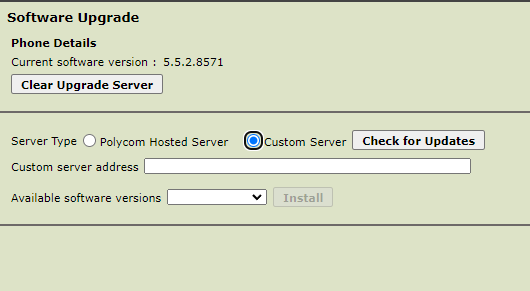No. The Poly’s allow you to update firmware from a local PC web browser, you don’t have to download it and then host it on a server you can download it to your PC and then use the webbrowser to upload it direct to the phone.
The thing is that provisioning the Polys is sort of tricky and not very well explained. On boot after factory reset the Polys will use the TFTP server IP provided in the standard TFTP DHCP server option to find a provisioning server and then automatically attempt to FTP login to that server using userID PlcmSpIp and same for password. If they find a provisioning file (name of their MAC address) then this file will provision and control the phone. You can specify the software version in this file and if so the phone will attempt to download it from the same provisioning server. In other words if all of the provisioning is setup locally, even if you login to the phone’s webinterface and click on the “check poly servers for update” and update the phone from them - on next reboot the phone will then downgrade to the firmware version on the provisioning server if it’s an older version.
Whne people use GUI tools to provision phones what ends up happening IMHO is they don’t understand how provisioning works. Every company that makes phones does it differently and the GUI tools attempt to create provisioning files for the phones and do them how those companies work - but the tools only know about how those phones firmware works with provisioning.
For example with FreePBX the commercial EPM tool creates provisioning files for the Sangoma phones and using EPM you can specify the firmware version. But, Sangoma could release a new phone firmware that changes the name the phone uses for a provisioning file - and then once the Sangoma phone updates, even on a factory reboot the phone will be uncontrolled now - until EPM is then updated to this new way of provisioning.
I don’t think Sangoma would be stupid enough to do this - but Polycom sure was since during the phone’s history they DID make changes - one of the biggest was sometime between version 3 or so of firmware and later, they changed the phone so it would no longer by default provision via TFTP and instead start provisioning via FTP.
That didn’t throw system admins who provisioned “by hand” by the time honored method using a template file, making a copy of it then changing the copy to the new extension and password for the new phone - and who also read the release notes for new firmware - but it sure did break a lot of provisioning software out there.
Even Cisco shot itself on the foot because of this - since they have released phone models that if you manually provisioned, you could take the phone through an entire firmware update sequence - but if you used their GUI provisioning tool to try doing the same thing you would end up with the phone stuck during migration from one firmware version to another.
I confess I have a soft spot for Poly’s because during it’s heyday the Polycom company concentrated on doing one thing and doing it well - and that was manufacturing VoIP phones. But even Polycom produced some dogs like the VVX 201 with no BLF key support, etc. But what ended up happening in the phone industry is all the phone manufacturers who survived realized that the way to make money was to force obsolescence and treat it like a razor/blade thing. That is, you don’t make your money from selling just phone systems or just phones but you make your money by selling the system + phones as an integrated whole. Then every 10 years or so you force-obsolete your older phone models and tell people “oh I see your phone system is falling apart and you need a new one - too bad so sad you are gonna have to throw away all your instruments and buy new ones” Then in many of these sales you end up making 10x the money selling people all new phones.
And the snake in the grass is that in 90% of those cases - if the customer WASN’T provisioning with the GUI provisioner - whether it’s EPM or Cisco’s UCM or whatever - their old phones would have continued to work perfectly with the new phone system. The only reason they “have” to spend $50k on all new phones is because they don’t understand centralized phone provisioning.
Nowadays some of those phone makers - like Yealink - figured out if they got up the asses of the various Cloud phone companies (Ring Central, etc.) and worked real closely with them so their phone models would be supported in the cloud phone companies’ GUI provisioners, then they could duplicate this same business model to force obsolescence.
Polycom never figured this out which is why they rose so high, then stumbled and went into free fall until HP bought 'em. But during their height they produced some very great phone models and if you have a site full of those phones and you learn how the phones work, you can continue to use those phones no matter what phone system you use in the future. Everything about them that the users encounter is sweet - even the ringtones are polite. You can tell when you pick up a Poly to make a call with it that the Poly engineers put a lot of effort into making a very nice instrument.
